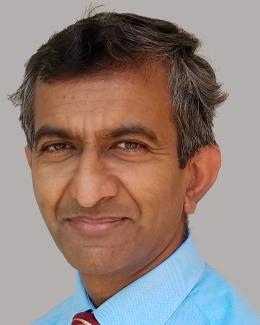
Dilip N Asthagiri
Senior Computational Biomedical Scientist
Bio
Dilip is a computational biophysicist & biomedical scientist in the Advanced Computing for Life Sciences and Engineering group of the Science Engagement Section in the National Center for Computational Sciences at ORNL. Dilip's research interests are in molecular thermodynamics & statistical mechanics of liquids and bio-macromolecules, the phenomena of hydration, physics of biological networks, NMR relaxation and simulations to guide the development of contrast agents for MRI, multiscale computer simulations, and inferential methods. In the OLCF, Dilip serves as a liaison for bio-molecular to bio-system modelers using OLCF resources.
Dilip received his doctorate from the University of Delaware (1999), Master's from the University of Michigan (1994), and Bachelor's from the Indian Institute of Technology-Madras (1992), all in Chemical Engineering. From 1999-2002 he was postdoctoral scholar at the Scripps Research Institute, La Jolla, where with his mentor Donald Bashford, he developed computational tools to study the enzymatic mechanism in a tyrosine phosphatase and probe the ion transport in synthetic nanotubes. To deepen his understanding of the statistical physics of aqueous phase processes, he pursued another postdoc in the Theoretical Chemistry and Molecular Biophysics group (T-12) at the Los Alamos National Laboratory (2002-2005). There with his mentor Lawrence Pratt he contributed to developing the molecular quasichemical theory of solutions, a framework to organize and conceptualize interactions in solutions. This framework helps not only in understanding experiments but it also provides a physically transparent way to make use of large scale molecular simulations with interaction models that range from empirical forcefields to ab initio quantum chemical potentials. He was later promoted to member of the Technical Staff at the Los Alamos National Laboratory (2005-2006).
Together with his students at the Johns Hopkins University, where he was an assistant professor (2006-20013), Dilip developed the quasichemical theory and simulation to probe the hydration thermodynamics of bio-macromolecules. These efforts enabled the world's first direct calculation of the hydration thermodynamics of a realistic protein from all-atom simulations using HPC. Studies since then have revealed fresh new insights into the assumptions implicit in extant studies of protein solution thermodynamics, culminating in providing breakthrough insights into decades old assumptions about hydrophobic hydration.
Dilip joined the Sealy Center for Structural Biology and Molecular Biophysics at the University of Texas Medical Branch (2013-2014). He later moved to Rice University where he was a senior research scientist and the Director of the Master's program (2014-2022) in the Department of Chemical and Biomolecular Engineering. He was later promoted to Associate Research Professor (2019-2022). At Rice, besides continuing his research in molecular biophysics, Dilip used large scale molecular simulations to understand nuclear magnetic resonance relaxation in bulk and confined liquids. These efforts led to the first clear identification of the limitations of classical models of NMR relaxation, models that inform much of the extant ideas in NMR logging and in interpreting MRI.

